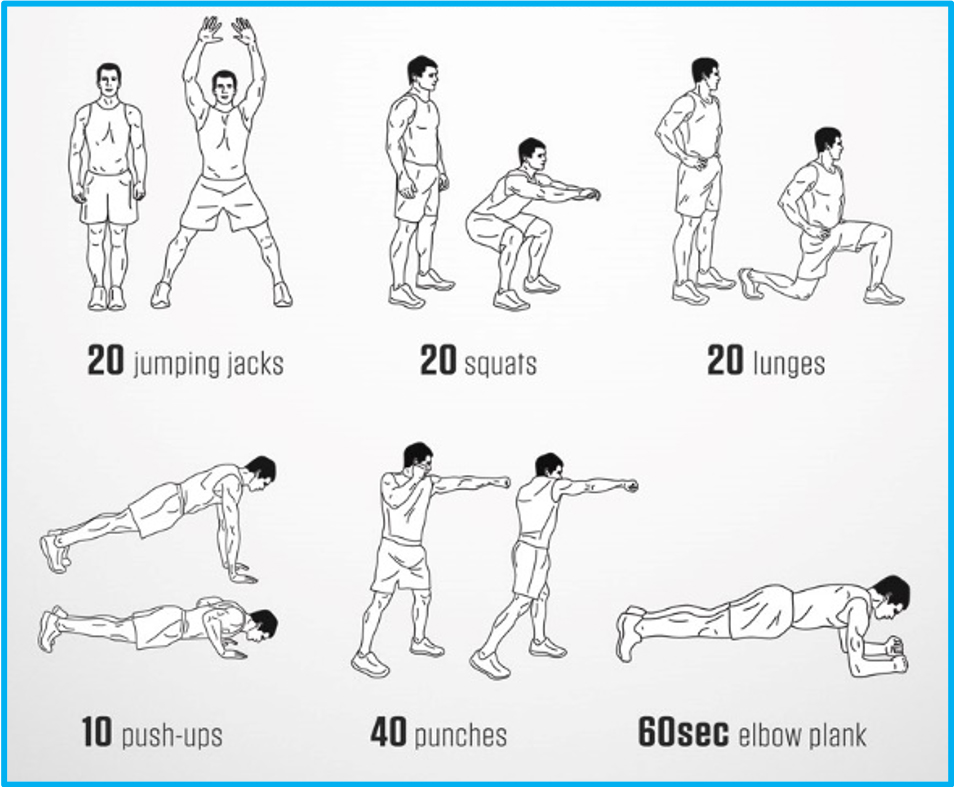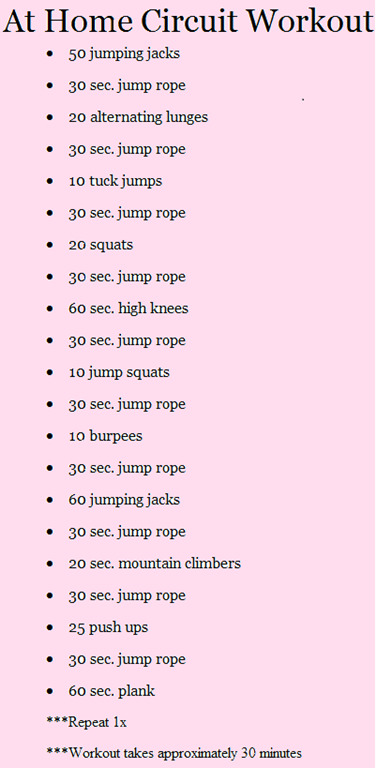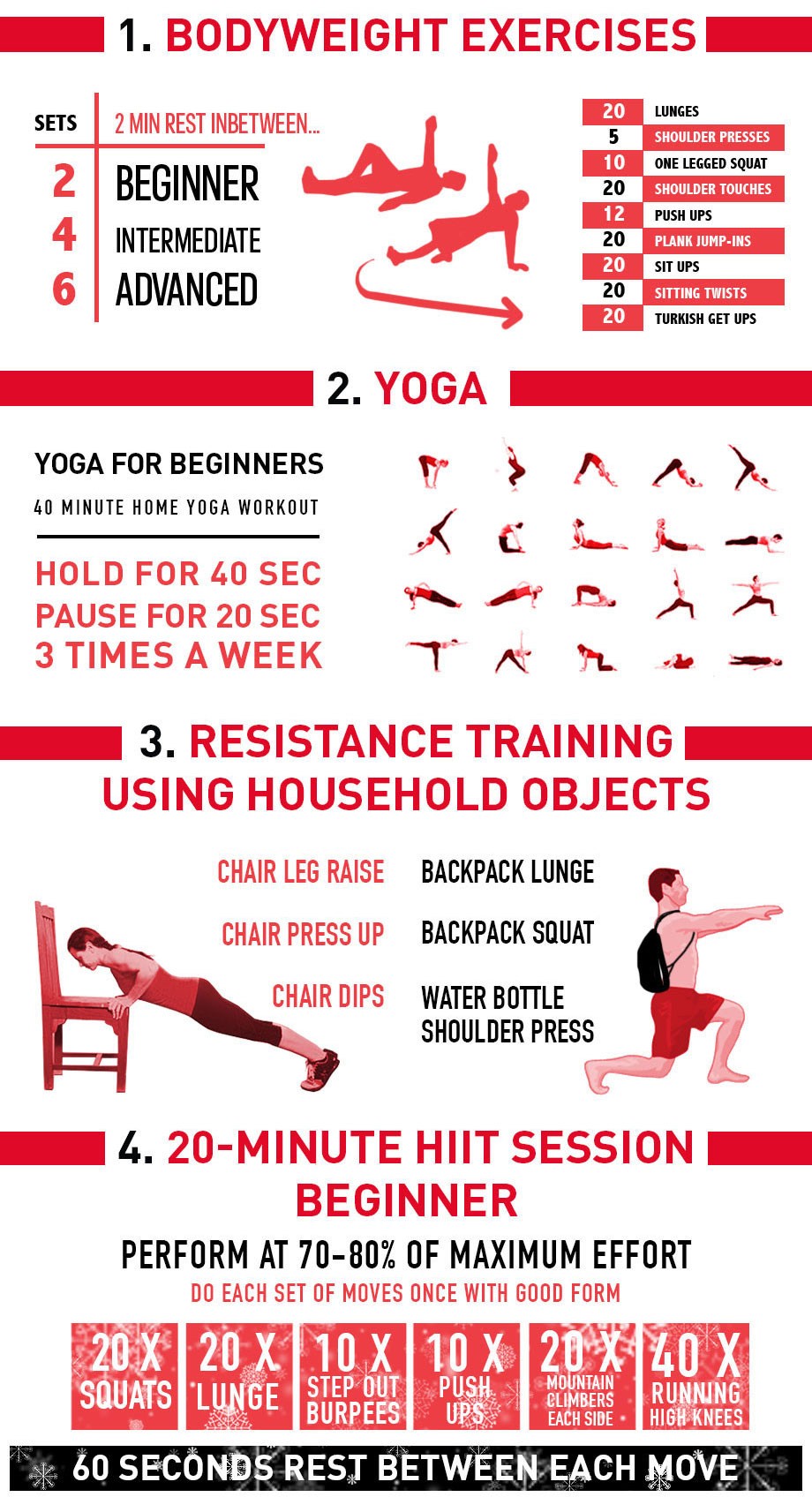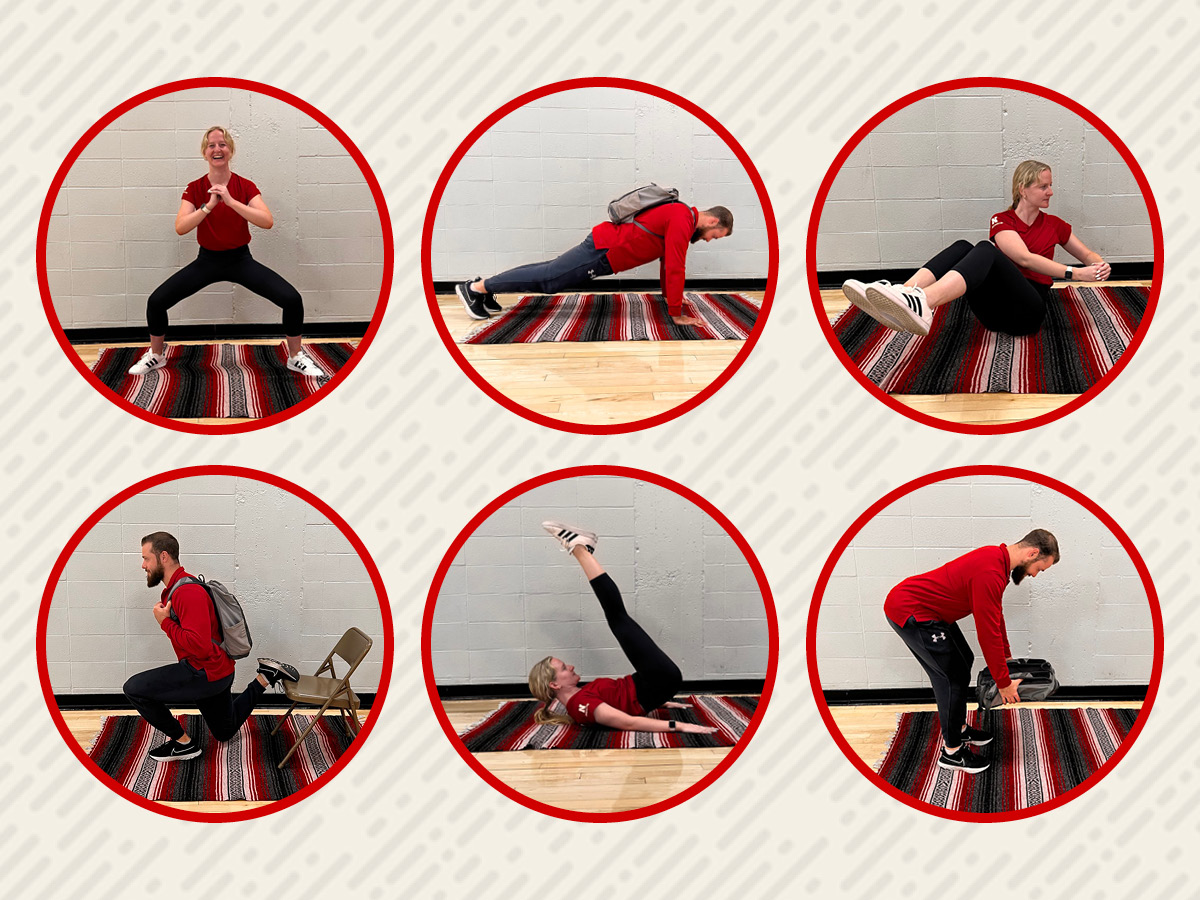Contents
- I. Introduction to Home Workouts Essentials
- II. Benefits of Home Workouts
- III. Setting Up Your Home Gym
- IV. Must-Have Equipment for Home Workouts
- 1. Dumbbells
- 2. Resistance Bands
- 3. Yoga Mat
- 4. Stability Ball
- 5. Jump Rope
- 6.Weight Bench If weightlifting is part of your fitness regimen, consider getting a weight bench. It provides stability and support for exercises like chest presses, tricep dips, step-ups, and more. Remember that the above equipment options are just suggestions and can vary based on your fitness goals and preferences. Start with what suits you best and gradually expand your home gym collection as you progress in your fitness journey.
- V. Choosing the Right Exercise Mat
- VI. Finding the Perfect Dumbbells for Your Home Gym
- VII. Resistance Bands: A Versatile Addition to Your Home Workouts
- VIII. Jump Rope: A Simple and Effective Cardio Tool
- IX. Stability Ball: Enhancing Core Strength and Balance
I. Introduction to Home Workouts Essentials

Welcome to the world of home workouts! Whether you are a fitness enthusiast or simply looking for a convenient way to stay active, home workouts offer a flexible and effective solution. With the right essentials in place, you can create your own personal gym within the confines of your home. In this article, we will explore the must-have items that will help you maximize your workout experience without stepping foot outside.
1. Workout Mat
A good quality workout mat is an essential item for any home gym setup. It provides cushioning and support for various exercises such as yoga, Pilates, and floor exercises. Look for a mat that offers adequate thickness and grip to ensure comfort and stability during your workouts.
2. Resistance Bands
Resistance bands are versatile tools that can be used to target different muscle groups effectively. They come in varying levels of resistance, allowing you to adjust the intensity based on your fitness level and specific exercise requirements. Incorporating resistance bands into your routine can add variety and challenge to bodyweight exercises.
3. Dumbbells or Kettlebells
Dumbbells or kettlebells are excellent additions to any home gym setup as they provide resistance training options for building strength and toning muscles. Start with a set of weights that match your current fitness level, gradually increasing as you progress.
4. Stability Ball
A stability ball is not only great for core strengthening exercises but also adds an element of instability, engaging multiple muscle groups simultaneously during workouts like planks or squats.
5. Jump Rope
A jump rope is an affordable yet highly effective cardiovascular exercise tool that helps burn calories while improving coordination and agility. It’s a compact option for getting your heart rate up without the need for large exercise equipment.
6. Foam Roller
A foam roller is an excellent recovery tool that aids in releasing muscle tension and improving flexibility. By incorporating foam rolling into your routine, you can help prevent injuries and enhance muscle recovery after intense workouts.
7. Fitness App or Online Workout Programs
With the multitude of fitness apps and online workout programs available, you have access to professional guidance right at your fingertips. These resources offer workout routines, video demonstrations, and progress tracking features to keep you motivated on your fitness journey.
8. Water Bottle and Towel
To ensure hydration during workouts, always have a water bottle nearby to sip on between sets or exercises. Additionally, keeping a towel handy will allow you to wipe away sweat and maintain cleanliness throughout your session.
II. Benefits of Home Workouts

When it comes to staying fit and healthy, home workouts have gained significant popularity in recent years. With the convenience of exercising from the comfort of your own home, there are numerous benefits that make it an attractive option for many individuals.
1. Flexibility and Convenience
One of the key advantages of home workouts is the flexibility they offer. You can exercise whenever it suits you best, without being constrained by gym operating hours or class schedules. This convenience allows you to seamlessly integrate fitness into your daily routine, making it easier to stay committed and consistent with your exercise regimen.
2. Cost-Effective
Gym memberships can be expensive, especially when factoring in additional costs like transportation and parking fees. By opting for home workouts, you eliminate these financial burdens. All you need are a few basic equipment items such as dumbbells or resistance bands, which are affordable and often last for years.
3. Privacy
If you’re someone who feels self-conscious about working out in public or being surrounded by strangers at the gym, then home workouts provide a comfortable alternative. Being able to exercise within the privacy of your own space allows for greater focus on your fitness goals without any external distractions or judgment.
4. Customization
A major advantage of home workouts is the ability to tailor them according to your specific needs and preferences. Whether you want to focus on strength training, cardio exercises, or flexibility routines – you have complete control over designing a workout plan that aligns with your goals.
5. Time-Saving
In today’s fast-paced world where time seems scarce, fitting in regular trips to the gym can be challenging. Home workouts eliminate the need for commuting and waiting for equipment, allowing you to make the most of your time. You can squeeze in a quick workout session during lunch breaks or whenever you have a free moment.
By taking advantage of these benefits, home workouts offer an effective and convenient way to improve your fitness levels. Whether you’re just starting your fitness journey or looking to maintain an active lifestyle, incorporating home workouts into your routine can lead to long-term health and wellness.
III. Setting Up Your Home Gym

Setting up a home gym can be an exciting and convenient way to stay fit without leaving the comfort of your own home. Whether you have limited space or a dedicated room, creating a functional and motivating workout space is essential for achieving your fitness goals. Here are some key steps to help you set up your home gym:
1. Define Your Fitness Goals
The first step in setting up your home gym is to clearly define your fitness goals. Are you looking to build strength, improve cardiovascular health, or lose weight? Understanding what you want to achieve will guide the equipment choices and layout of your gym.
2. Assess Your Space
Evaluate the available space in your home that can be dedicated to a workout area. Consider factors such as ceiling height, flooring type, and ventilation. Choose a spot where you have enough room for movement during exercises and ensure there’s sufficient lighting.
3. Select Essential Equipment
Determine the essential equipment based on your fitness goals and available space. Some versatile options include dumbbells, resistance bands, stability balls, jump ropes, yoga mats, and adjustable benches. Invest in quality equipment that suits both beginner and advanced workouts.
4. Create an Organized Layout
An organized layout optimizes the functionality of your home gym while maximizing available space efficiently. Place larger equipment against walls or corners while keeping smaller items within easy reach on shelves or storage racks.
5. Consider Safety Measures
Prioritize safety by ensuring proper ventilation and installing appropriate flooring like rubber mats or interlocking tiles that provide grip and absorb impact during exercises such as weightlifting or high-intensity workouts.
6. Personalize Your Space
Add personal touches to make your home gym an inspiring and enjoyable environment. Hang motivational posters, play energizing music, or incorporate plants for a refreshing atmosphere. Make it a place you look forward to visiting every day.
7. Set Up a Schedule
Establishing a workout schedule will help you maintain consistency and ensure you make the most of your home gym. Determine the best time of day for your workouts and set aside dedicated time for exercising regularly.
8. Keep It Clean
Maintaining cleanliness in your home gym is crucial for hygiene and longevity of equipment. Regularly wipe down surfaces, clean mats, and disinfect equipment handles to prevent the spread of germs.
By following these steps, you can create an inviting and effective home gym that suits your fitness needs while providing convenience and motivation to achieve your health goals!
IV. Must-Have Equipment for Home Workouts

When it comes to staying fit and active at home, having the right equipment can make all the difference in achieving your fitness goals. Whether you’re a beginner or a seasoned fitness enthusiast, here are some must-have equipment options for effective home workouts:
1. Dumbbells
Dumbbells are versatile and essential for any home workout routine. They come in various weights, allowing you to adjust the intensity of your exercises based on your strength level. With dumbbells, you can perform exercises like bicep curls, shoulder presses, lunges, and more.
2. Resistance Bands
If you’re looking for a portable and affordable option to add resistance to your workouts, resistance bands are the way to go. These elastic bands come in different strengths and can be used for various exercises such as squats, glute bridges, rows, and even upper body workouts.
3. Yoga Mat
A comfortable yoga mat is essential if you want to engage in activities like yoga or floor exercises at home. It provides cushioning and support while protecting your knees and joints during high-impact movements.
4. Stability Ball
A stability ball is not only great for core strengthening but also helps improve balance and flexibility. It can be used for exercises such as crunches, planks, push-ups with added instability challenge.
5. Jump Rope
A jump rope might take you back to childhood memories but incorporating it into your workout routine brings numerous benefits including cardio endurance improvement while working multiple muscle groups simultaneously.
6.Weight Bench
If weightlifting is part of your fitness regimen, consider getting a weight bench. It provides stability and support for exercises like chest presses, tricep dips, step-ups, and more.
Remember that the above equipment options are just suggestions and can vary based on your fitness goals and preferences. Start with what suits you best and gradually expand your home gym collection as you progress in your fitness journey.
V. Choosing the Right Exercise Mat
When it comes to home workouts, having the right exercise mat is essential for comfort, stability, and safety. With so many options available in the market, choosing the perfect mat can be a daunting task. However, by considering a few key factors, you can easily find an exercise mat that meets your needs and preferences.
1. Thickness
The thickness of an exercise mat plays a crucial role in providing adequate cushioning and support during workouts. Thicker mats are generally more comfortable, especially when performing exercises that involve kneeling or lying down. On the other hand, thinner mats are ideal for activities that require better stability and balance.
2. Material
The material used in an exercise mat determines its durability and grip. Mats made from high-quality materials like natural rubber or PVC are long-lasting and offer excellent traction to prevent slipping during workouts. Additionally, these materials are easy to clean and maintain.
3. Size
The size of the exercise mat should be suitable for your workout space as well as your body dimensions. A standard-sized mat is usually around 68 inches long and 24 inches wide – sufficient for most exercises. However, taller individuals may prefer longer mats to accommodate their height without compromising on comfort or technique.
4. Texture
The texture of an exercise mat affects both grip and comfort while exercising. Mats with textured surfaces provide better traction than those with smooth surfaces since they create friction against your hands or feet during movements such as yoga poses or push-ups.
5.Sustainability
If environmental sustainability is important to you, consider opting for eco-friendly exercise mats made from recycled materials or natural fibers like cork or jute instead of synthetic materials. These mats are not only better for the planet but also offer similar performance and durability.
6. Price
Exercise mats come in a wide range of prices, so it’s essential to set your budget beforehand. While premium mats may offer superior quality and features, there are also affordable options available that provide adequate support and comfort for your workouts.
Choosing the right exercise mat requires careful consideration of factors such as thickness, material, size, texture, sustainability, and price. By understanding your specific needs and preferences, you can find an exercise mat that enhances your home workout experience while keeping you comfortable and safe.
VI. Finding the Perfect Dumbbells for Your Home Gym
When it comes to setting up a home gym, one of the most essential pieces of equipment you’ll need is a set of dumbbells. But with so many options available on the market, how do you find the perfect dumbbells for your specific needs? Here are some factors to consider:
Type of Dumbbells
There are several types of dumbbells to choose from, including adjustable, fixed-weight, and selectorized. Adjustable dumbbells allow you to change the weight plates according to your preference, making them versatile and space-saving. Fixed-weight dumbbells come in various weights but cannot be adjusted. Selectorized dumbbells have a dial or pin mechanism that allows you to select different weights.
Weight Range
The weight range is an important consideration when choosing dumbbells for your home gym. Consider your current fitness level and goals. If you’re just starting out or prefer lighter weights for toning exercises, opt for a set that offers lower weight increments. On the other hand, if you’re more advanced or want to focus on building muscle strength, look for sets with higher weight options.
Grip Comfort
A comfortable grip is crucial during workouts as it ensures proper form and reduces strain on your hands and wrists. Look for dumbbells with textured handles that provide a secure grip even when sweating. Some models also feature ergonomic designs that fit comfortably in your hand.
Durability and Quality
You want your dumbbell set to last long without any wear or tear issues. Opt for high-quality materials such as cast iron or steel construction that can withstand heavy use over time without breaking or rusting.
Storage and Space
Consider the available space in your home gym and how you plan to store the dumbbells when not in use. Adjustable dumbbells are compact and can be easily stored on a rack or in a designated area. Fixed-weight dumbbells, on the other hand, require more space as you’ll need individual racks for each weight.
By taking these factors into account, you can find the perfect set of dumbbells that meet your fitness goals, preferences, and budget. Remember to always prioritize quality and comfort when making your selection.
VII. Resistance Bands: A Versatile Addition to Your Home Workouts
When it comes to home workouts, finding versatile equipment that can target multiple muscle groups and provide a challenging workout is essential. One such piece of equipment that fits the bill perfectly is resistance bands. These elastic bands offer a wide range of exercises that can be tailored to your fitness level and goals.
Affordable and Portable
Resistance bands are not only effective but also affordable and portable, making them an ideal addition to any home gym setup. Unlike bulky gym machines or free weights, resistance bands take up minimal space and can be easily packed for travel or outdoor workouts.
Muscle Activation
Using resistance bands engages multiple muscles simultaneously, helping you build strength and endurance effectively. Whether you’re targeting your arms, legs, chest, back, or core muscles, these bands provide constant tension throughout the exercise movement.
Variety of Exercises
One of the greatest advantages of resistance bands is their versatility. From bicep curls and tricep extensions to squats and lunges, there are countless exercises that can be performed with these bands. Additionally, by adjusting the band’s position or grip on the handles, you can increase or decrease the level of difficulty for each exercise.
Injury Prevention
Resistance bands also offer a low-impact option for individuals recovering from injuries or those who want to minimize stress on their joints while still getting a challenging workout. The controlled tension provided by resistance bands helps improve stability in joints without putting excessive strain on them.
Fits All Fitness Levels
No matter if you’re a beginner looking to start your fitness journey or an advanced athlete seeking more intensity in your workouts, resistance bands can accommodate all fitness levels. With various resistance levels available, you can easily progress as you get stronger and fitter.
Enhanced Flexibility
Incorporating resistance bands into your home workouts can also improve your flexibility and range of motion. By stretching with the bands before or after exercises, you can enhance your overall flexibility, which is crucial for preventing injuries and improving performance in other activities.
Full-Body Workouts
With the right combination of exercises, resistance bands allow you to target every major muscle group in your body. From upper body workouts like shoulder presses to lower body exercises like glute bridges, these bands provide a complete full-body workout that challenges all areas of your physique.
In summary, resistance bands are an excellent addition to any home workout routine due to their affordability, portability, versatility in exercises targeting different muscle groups, injury prevention benefits, suitability for all fitness levels, ability to enhance flexibility and range of motion while providing a full-body workout experience.
VIII. Jump Rope: A Simple and Effective Cardio Tool
When it comes to home workouts, there are countless tools and equipment that can help you achieve your fitness goals. One such tool that often gets overlooked is the humble jump rope. Not only is it affordable and easily accessible, but it also provides a fun and effective way to get your heart rate up and improve cardiovascular endurance.
A Versatile Workout Option
The jump rope offers a versatile workout option that can be tailored to suit individuals of all fitness levels. Whether you’re a beginner or an advanced athlete, the intensity of your jump rope workout can be adjusted by simply altering the speed or incorporating different jumping techniques.
For beginners, starting with a basic two-foot jump is a great way to build coordination and endurance. As you progress, you can challenge yourself with more advanced moves like single-leg jumps or double unders. The options are endless!
Burn Calories in Less Time
If time efficiency is important to you, then incorporating jump rope exercises into your routine can be highly beneficial. Jumping rope for just 10 minutes at a moderate pace can burn around 100 calories – equivalent to running at an 8-minute mile pace! This makes it an excellent choice for those who have limited time but still want to maximize their calorie burn.
No Space? No Problem!
One of the biggest advantages of using a jump rope for cardio workouts is that it requires very little space. Unlike bulky exercise machines or weights, all you need is enough room to swing the rope comfortably without any obstructions. This makes it perfect for apartment dwellers or those with limited workout space.
A Full-Body Workout
Jumping rope engages multiple muscle groups throughout your body, making it a fantastic full-body workout. Not only does it target your legs and glutes, but it also engages your core, shoulders, and arms as you maintain balance and control while jumping.
Additionally, jumping rope can improve your coordination, agility, and overall cardiovascular fitness. It’s a great way to strengthen your heart and lungs while enhancing your athletic performance in other activities.
Conclusion
The jump rope may seem like a simple tool, but its benefits are far-reaching. Incorporating jump rope exercises into your home workouts can boost calorie burn, improve cardiovascular endurance, and provide an enjoyable way to stay active. So grab a jump rope today and start reaping the rewards of this effective cardio tool!
IX. Stability Ball: Enhancing Core Strength and Balance
The stability ball, also known as an exercise ball or Swiss ball, is a versatile piece of equipment that can be used to enhance core strength and improve balance. It is a large inflatable ball made of elastic material that provides an unstable surface for various exercises.
1. Benefits of Using a Stability Ball
Using a stability ball in your home workouts offers numerous benefits. Firstly, it engages multiple muscle groups simultaneously, including the abdominals, back muscles, and hip muscles. This helps strengthen your core and improve overall stability.
Secondly, exercising on a stability ball requires you to maintain balance throughout the movements, which activates smaller stabilizer muscles that are often neglected during traditional exercises.
In addition to strengthening your core and improving balance, using a stability ball can also help with posture correction and spinal alignment. The unstable surface forces you to engage your deep abdominal muscles to maintain proper form during each exercise.
2. Core-Strengthening Exercises on the Stability Ball
The stability ball offers endless possibilities for core-strengthening exercises at home. Here are some examples:
- Ball Crunches: Sit on the ball with feet planted firmly on the ground and perform crunches while maintaining balance on the unstable surface.
- Bridge Rollouts: Lie down with your upper back resting on the stability ball and feet flat on the floor. Lift your hips off the ground into a bridge position while rolling the ball away from you using only your legs.
- Russian Twists: Sit upright with feet hip-width apart while holding onto the sides of the stability ball. Twist your torso from side to side, engaging your oblique muscles.
3. Balance-Improving Exercises on the Stability Ball
Incorporating balance-improving exercises into your home workouts can help you develop better stability and coordination. Here are a few exercises to try:
- Single-Leg Squats: Stand with one foot placed firmly on the stability ball and extend your other leg straight in front of you. Slowly lower yourself into a squat position while maintaining balance.
- Plank Rollouts: Assume a plank position with your forearms resting on the stability ball. Roll the ball forward by extending your arms, then roll it back by pulling it towards you using only your core muscles.
The stability ball is an excellent addition to any home workout routine as it challenges both core strength and balance simultaneously. Remember to start with basic exercises and gradually progress as you build strength and improve stability. Always maintain proper form during each exercise to prevent injuries.

Shelby Cortez is a dynamic and passionate individual with a strong background in the fitness industry. With a Bachelor’s degree in Exercise Science from the prestigious University of California, she has gained extensive knowledge about the human body and its mechanics. Shelby’s dedication to fitness goes beyond her education, as she has spent years honing her skills as a personal trainer and group fitness instructor. Her expertise in workout routines and nutrition has helped countless individuals achieve their fitness goals. Shelby’s commitment to health and wellness is evident in her own lifestyle, as she consistently pushes herself to new limits in the gym. Whether it’s weightlifting, yoga, or HIIT workouts, Shelby Cortez is the go-to expert for all things fitness-related.
